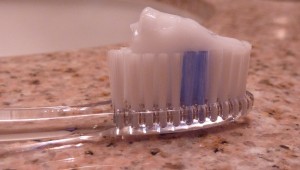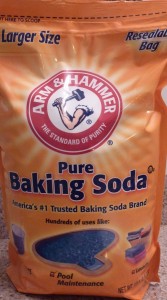 Brushing your teeth in the wilderness is a different experience than standing in front of a bathroom sink with freely flowing tap water. We researched a few options for you to consider as part of your cavity & plaque prevention in the woods.
Brushing your teeth in the wilderness is a different experience than standing in front of a bathroom sink with freely flowing tap water. We researched a few options for you to consider as part of your cavity & plaque prevention in the woods.
Toothbrush Options
- Standard – pack out the same toothbrush you use at home. Pack it in a zip-top bag. No extra expense is required. You can also purchase a plastic vented toothbrush cap for about $1 to keep the brush dry and clean.
- Travel Size – use a standard 2-piece travel-sized toothbrush where the brush fits securely in a plastic capped container that doubles as a handle. Many backpackers opt for this since it is lightweight, packs up small, and the brush is kept clean and dry (look for vent holes in the cap). You can find these in any drugstore.
- Kid Size – purchase a standard kid-size toothbrush to save on weight.
- Custom – some ultralight backpackers cut off the excess plastic from the handle of a standard-sized toothbrush to save on weight.
- All-in-One – the Toob toothbrush made by Aurelle is a combination brush, paste, and carrying case. It contains a refill tube to put your desired toothpaste in the handle.
- Disposable – a single-use mini toothbrush that contains embedded toothpaste in the brush. The paste dissolves from the saliva in your mouth. Wasteful, expensive, and single-use.

Tooth Paste / Powder Options
Many tooth powders use baking soda or chalk as the primary ingredient and contain various extracts to give it flavor. Some have added ingredients to provide extra abrasion. Common tooth powder brands include:
- Uncle Harrys – all natural ingredients. Chalk (calcium carbonate) is the primary ingredient.
- Eco-Dent – baking soda is the primary ingredient. Steer away from this one. It uses many chemical additives and preservatives, including Sodium Methyl Cocoyl Taurate, a chemical derived from questionable sources such as Ox Bile (Oxgall : emulsifier from the fresh bile of castrated bovines).
- Monkey Brand – coal is the primary ingredient. Contains other natural extracts from flowers and herbs to provide astringent and antibacterial properties common to Ayurveda.
- Peelu – uses ground tree fibers from the peelu tree and natural oils for flavoring.
- Arm & Hammer – plain baking soda (sodium bicarbonate). This simple chemical works very well. It is also convenient as most of us already have it at home.
We will not cover the common toothpaste brands since these are well known; however, one you may have yet to consider using for cleaning your teeth is Dr Bronners 18-1 Hemp Castille Soap. All you need is 1 drop on your brush, as it is a highly concentrated soap. We use the peppermint version, and while the minty flavor is strong, it does tingle your mouth and wake up your senses. The cleaning power is very effective, and it’s natural and biodegradable. Don’t expect it to lather and foam like a standard toothpaste containing chemical surfactants such as sodium lauryl sulfate. A small 4 oz bottle of Bronners 18-1 soap goes a long way. We discuss some of the multiple uses of Dr. Bronners here.
Using Baking Soda
You can minimize environmental impacts using baking soda instead of toothpaste or toothpowder. Plain baking soda (sodium bicarbonate) cleans and whitens teeth well.
Put the powder in a ziploc bag or small travel container. You do not need to take much – ¼ cup will last approximately 6 days when brushing twice daily. When brushing, dampen the toothbrush with a small amount of water, dip the moistened toothbrush into the powdered mixture (~ 1 tsp), then brush as usual.
Advantages of Baking Soda
- Naturally odorless.
- Has multiple uses that come in handy in the woods: cleaning (teeth, dishes, skin, hair), antacid (heartburn, upset stomach, indigestion), odor control (boots, socks, underarm deodorant), pain relief (cancer sores, bee stings, insect bites, sunburn).
Forgot the Paste / Powder?
You can also practice “dry brushing” if you forget or don’t want to carry out any powder or paste. Just brush your teeth, gums, and tongue a few times in a with a dampened toothbrush. Forget your toothbrush too? Swish your mouth a few times with drinkable water. Dampen a rag or bandanna and roll it over your teeth in a circular motion.
Brushing is what counts
The brand or type of toothpaste/powder you use is unimportant. The motion of brushing displaces food particles and tartar buildup from your teeth. The only noticeable difference in using standard toothpaste is that it leaves a minty aftertaste – what many of us equate to fresh breath. We wouldn’t recommend adopting this habit every day, though!
Spitting Out Tooth Paste
- Don’t spit the toothpaste into one spot. This is especially important if you use traditional minty gels or pastes since wildlife will be attracted to the scent. Swish your mouth with water, then spray the residue over a wide area.
- Spit into the same cathole you are using as a bathroom.
Enjoy the trails!

One thought on “Brushing Teeth Outdoors”
Thanks for sharing most of us don’t really follow these rules but this is an eye opener for clean good breath teeth.